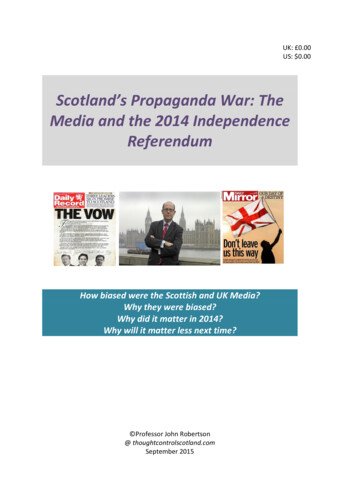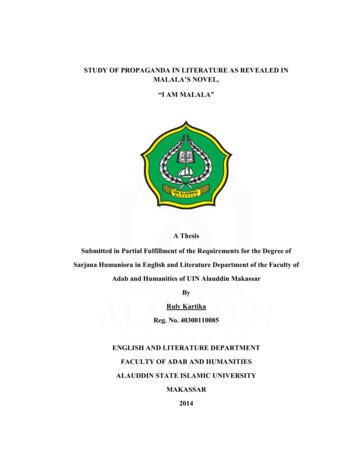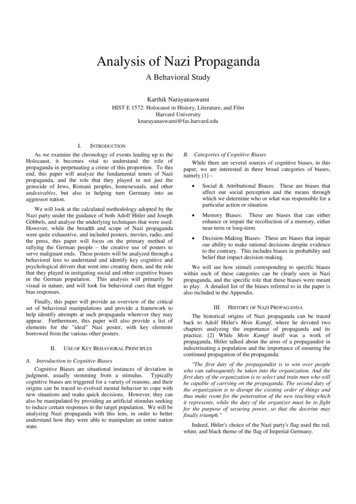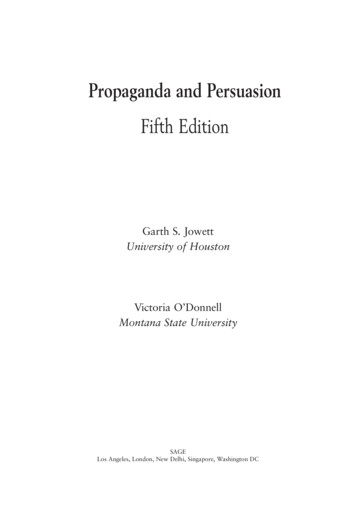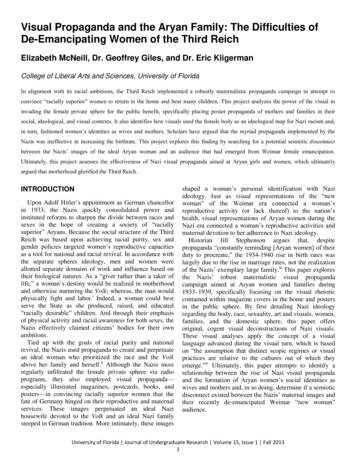
Transcription
Visual Propaganda and the Aryan Family: The Difficulties ofDe-Emancipating Women of the Third ReichElizabeth McNeill, Dr. Geoffrey Giles, and Dr. Eric KligermanCollege of Liberal Arts and Sciences, University of FloridaIn alignment with its racial ambitions, the Third Reich implemented a robustly maternalistic propaganda campaign in attempt toconvince “racially superior” women to return to the home and bear many children. This project analyzes the power of the visual ininvading the female private sphere for the public benefit, specifically placing poster propaganda of mothers and families in theirsocial, ideological, and visual contexts. It also identifies how visuals used the female body as an ideological map for Nazi racism and,in turn, fashioned women’s identities as wives and mothers. Scholars have argued that the myriad propaganda implemented by theNazis was ineffective in increasing the birthrate. This project explores this finding by searching for a potential semiotic disconnectbetween the Nazis’ images of the ideal Aryan woman and an audience that had emerged from Weimar female emancipation.Ultimately, this project assesses the effectiveness of Nazi visual propaganda aimed at Aryan girls and women, which ultimatelyargued that motherhood glorified the Third Reich.INTRODUCTIONUpon Adolf Hitler’s appointment as German chancellorin 1933, the Nazis quickly consolidated power andinstituted reforms to sharpen the divide between races andsexes in the hope of creating a society of “raciallysuperior” Aryans. Because the social structure of the ThirdReich was based upon achieving racial purity, sex andgender policies targeted women’s reproductive capacitiesas a tool for national and racial revival. In accordance withthe separate spheres ideology, men and women wereallotted separate domains of work and influence based ontheir biological natures. As a “giver rather than a taker oflife,” a woman’s destiny would be realized in motherhoodand otherwise nurturing the Volk; whereas, the man wouldphysically fight and labor.i Indeed, a woman could bestserve the State as she produced, raised, and educated“racially desirable” children. And through their emphasisof physical activity and racial awareness for both sexes, theNazis effectively claimed citizens’ bodies for their ownambitions.Tied up with the goals of racial purity and nationalrevival, the Nazis used propaganda to create and perpetuatean ideal woman who prioritized the race and the Volkabove her family and herself.ii Although the Nazis mostregularly infiltrated the female private sphere via radioprograms, they also employed visual propaganda––especially illustrated magazines, postcards, books, andposters––in convincing racially superior women that thefate of Germany hinged on their reproductive and maternalservices. These images perpetuated an ideal Nazihousewife devoted to the Volk and an ideal Nazi familysteeped in German tradition. More intimately, these imagesshaped a woman’s personal identification with Naziideology. Just as visual representations of the “newwoman” of the Weimar era connected a woman’sreproductive activity (or lack thereof) to the nation’shealth, visual representations of Aryan women during theNazi era connected a woman’s reproductive activities andmaternal devotion to her adherence to Nazi ideology.Historian Jill Stephenson argues that, despitepropaganda “constantly reminding [Aryan women] of theirduty to procreate,” the 1934-1940 rise in birth rates waslargely due to the rise in marriage rates, not the realizationof the Nazis’ exemplary large family.iii This paper exploresthe Nazis’ robust maternalistic visual propagandacampaign aimed at Aryan women and families during1933–1939, specifically focusing on the visual rhetoriccontained within magazine covers in the home and postersin the public sphere. By first detailing Nazi ideologyregarding the body, race, sexuality, art and visuals, women,families, and the domestic sphere, this paper offersoriginal, cogent visual deconstructions of Nazi visuals.These visual analyses apply the concept of a visuallanguage advanced during the visual turn, which is basedon “the assumption that distinct scopic regimes or visualpractices are relative to the cultures out of which theyemerge.”iv Ultimately, this paper attempts to identify arelationship between the rise of Nazi visual propagandaand the formation of Aryan women’s social identities aswives and mothers and, in so doing, determine if a semioticdisconnect existed between the Nazis’ maternal images andtheir recently de-emancipated Weimar “new woman”audience.University of Florida Journal of Undergraduate Research Volume 15, Issue 1 Fall 20131
ELIZABETH MCNEILL, DR. GEOFFREY GILES, & DR. ERIC KLIGERMANFascism and the Female Body: Ideology and theImageOn September 8, 1934, Hitler defined the Party’s attitudetowards emancipation, women, and their nature in hisaddress to the National Socialist Women’s section (NSF):In the really good times of German life the Germanwoman had no need to emancipate herself. Shepossessed exactly what nature had necessarily givenher to administer and preserve; just as the man in hisgood times had no need to fear that he would beousted from his position in relation to the woman .Our National Socialist Women’s movement has inreality but one single point, and that point is the child,that tiny creature which must be born and grow strongand which alone gives meaning to the whole lifestruggle.5According to Hitler, German greatness waned as womendenied their nature, instead stealing and donning the malerole. Since nature had equipped women with bodies forproducing children, destiny called them to preserve andempower the nation through their primary bodilycapability: reproduction. In essence, Hitler’s definition ofnational greatness depended upon racial purity. In theracially superior Aryans’ “eternal struggle” against theirenemies, women participated as the home-front fightingforces: their bodies fortified the Aryan race againstdegeneration. Just as men were encouraged to offer theirlives to Germany’s fight, Hitler encouraged women toemploy this same selfless attitude in their reproductivelabors and daily sacrifices. By emphasizing the individualwoman’s vital role as a mother within the collective bodyof the Volksgemeinschaft (“people’s community”) and heracts of bodily self-sacrifice for the race, the Naziscompletely absorbed her private body into public affairs.The Nazis sought to redirect women’s confused anddiffused sexual energies (embodied in the sexuallyliberated and masculinized Weimar “new woman”) towardthe glory of the Third Reich in the goal of expansion(Lebensraum) by calling them to produce racially superiorVolksgenossen (“national comrades”) with which topopulate Germany, Europe, and eventually the world.6Through a constantly reverberating “rhetoric of selectivenatalism” that permitted racially acceptable Germans toenjoy sex, the Nazis created new attitudes towardssexuality that abandoned both Victorian prudency and“degenerate” Weimar sexuality.7 But because the idealNazi woman surrendered her biological functions toregenerating and strengthening the German population, thefunction of sex was actually the “maintenance of life forthe nation and not the enjoyment of the individual.”8 Whilethe sexual function of female bodies was ideological, it wasalso practical––a woman’s heterosexual practices stabilizedthe racial, political, and social ambitions of the ThirdReich.9Undoubtedly, the Ministry of Public Enlightenment andPropaganda was highly selective in what bodiesrepresented the ideal, thereby employing a “racistaestheticism” that propagated “bodies whose beauty wassupposed to demonstrate superiority over human beingsfrom other races.”10 As Nazi ideology and visuals elevatedthe Aryan body, the nude female form especiallyarticulated Nazi ideology, cultural history, racial identity,and social attitudes.11 By representing the people’sattachment to blood, soil, and destiny, artistic images offemale bodies referenced Nazi ideology’s rendering ofnaturalism, which claimed to put people in touch with theirnatural racial and biological responses.12 As Nazirepresentations of the female body reclaimed an affinitywith nature, they evoked the Aryan peoples’ primordialnature, desire for a racially pure state, and assurance oftheir own racial superiority. The articulation of racistideology contained within the nude form sustained theNazis’ racist body culture and perpetuated theentrenchment of racial ideology within the aesthetics of thefemale body.By extension, a woman’s healthy Aryan body served asa microcosm of the healthy fascist state, a theme whichwas “reiterated in the images of the ‘sacred wife andmother’ in officially sanctioned art and promoted in a vastcampaign enjoining women to lend their bodies to themovement to maintain the vitality of the race.”13 Indeed,Nazi art and other images propagated racially ideal Nordicwomen whose youthful and de-eroticized bodiesinvalidated the deformed bodies of Weimar modernist art.14But more importantly, these images exalted the Aryanfemale body as the mother of a consummate racial statethrough her bodily sacrifice of birthing many children. TheAryan mother was the culminating model for women of theThird Reich.A Woman’s Place: Bodies and DestiniesThe Nazis’ social vision was a modern rendition of thetraditional separation-of-spheres ideology, which presumesa biological difference between the sexes that determinestheir “natural” sphere of assignments: a woman’s “natural”place is with the children in the home and the man’s“natural” place is in the public sphere. A rhetoricallyflexible and traditional Nazi ideal woman thus emerged: awoman’s greatest contribution to society would be throughher family––the “‘life source’ of the people.”15 In turn, theParty specifically addressed women’s concerns byupgrading attitudes towards and expanding upon women’swork, encouraging Aryan women to embrace their“natural” domestic role as housewives and mothers, andplacing great value on their racial contributions as thebearers and educators of future generations.16 NaziUniversity of Florida Journal of Undergraduate Research Volume 15, Issue 1 Fall 20132
VISUAL PROPAGANDA AND THE ARYAN FAMILYideology sought not to force women into a new role, butrather to praise and encourage the unique contributionsthey could make as women.17As evidenced by the Nazis’ aim to physically strengthenAryans in order to propagate a healthy race, the racialconcerns of the Third Reich trumped gender concerns andultimately structured society.18 To be sure, the State’s mainfocus was not on politically silencing women or pushingthem back into the home, but on reconstructing societyaccording to its racial ideologies.19 Women were valued fortheir reproductive abilities, which could be best encouragedif they remained in the private sphere. Racism precededand molded sexism: the Nazis emphasized the separation ofspheres for its ability to contribute to their larger racialaims. The ideal woman’s concerns rested with the race andVolk, far above her family and herself.20The Nazi separation of spheres––and the propagation ofthe ideal domestic mother figure therein––was flexible,practical, and offered Aryan women an important semiindependent status within the Reich.21 Because the strictmaintenance of the distinction between the sexes was lessimportant than that of the races, the exclusive emphasis onwomen’s roles as mothers could not stand in the face ofmore pressing racial, social, and economic needs. Duringthe period of 1933–1939, the image of the “mother of theVolk” remained stable; but beginning in 1939, the wartimerequirements of women bent to satisfy wartime economicdemand. 22 Indeed, motherhood served the Reich’spurposes, rather than existing solely as a spiritual andmoral ideal.Shaping the Ideal Woman: Visual Propaganda inthe HomeThe Third Reich employed the persuasive power ofimages. In both the public and private spheres, imagesexcluded racial and social “outcasts,” posited an idealcitizen, and then molded people via ideological trainingand identification with the ideal. Before attending to therhetorical intricacies of posters in shaping Aryan women asmothers and housewives, one must examine thepropagandistic visuals that invaded their private lives, mostnotable being magazine covers.23To be sure, posters in the public sphere did not exist in apropagandistic vacuum––a poster was intended to effectclear visual communication, but its message was anelement in a coordinated ideological attack intended toshape a highly partitioned, racially ideal society. Becausemagazine covers functioned similarly to poster propagandain the clarity, simplicity, and attention-grabbing power oftheir visual message, this paper will therefore treatmagazine covers as poster propaganda intended for homeuse while simultaneously recognizing advantages for thehistorian in analyzing magazine covers. Indeed, amagazine’s affiliation with a specific Nazi organizationenables one to understand the motivations behind theimages and then follow the progression of communicatingthat ideology. Moreover, the date on the cover allows thehistorian to confidently identify the visual’s historicalmoment.In general, illustrated magazines were especiallyeffective pieces of propaganda because the viewer couldhold the slim volume in her hands, flip through its colorfulpages, and personally interact with it on a level notavailable in poster propaganda. Through its potentialplacement within the home on the family-room coffeetable, the magazine assimilated into a woman’s home, life,and consciousness. And the short articles and clear imageswithin magazines corresponded with the Nazis’expectations of a busy housewife’s schedule: althoughideological training was of vital importance, she shouldforego heavy reading and care for her children, husband,and home instead.The most important women’s magazine wasFrauenwarte (“Women’s Outlook”), which was the Party’sofficial biweekly illustrated magazine. Frauenwarteemphasized women’s roles as housewives and motherswith articles on practical domestic tips, childcare advice,and other topics that would particularly interesthousewives. The 1937/1938 illustrated cover (Figure 1)perfectly demonstrates the magazine cover’s effectivenessin visually communicating Nazi ideology. In this particularimage, a blonde woman sits in the foreground and holds asmiling blonde baby girl upon her bosom. Directly behindher, a tanned, blonde man brandishes a sword and shield––an explicit reference to the Nordic fighting ideal. Behindhim and to the left, an agricultural worker plows a fieldoutside of the picture. The distinction between male andfemale social roles, reminiscent of Hitler’s description ofpersonal struggle, is apparent: the woman rests in theprivate sphere with her child, whereas the men labor andfight in the field. Although the hierarchical nature of theimage places the baby and woman (private sphere) belowthe men (public sphere), the sun (Germany’s “day in thesun,” as realized in the Third Reich) triumphs above bothin the upper-left corner. By way of further harmonizing thecharacters, all four stare into the same distance, whichrepresents the glorious future of the Reich. Crucially, thenature of their individual stares, coupled with their tasks,dictates the means by which each Aryan man, woman, andchild can achieve that future. This cover’s portrayal of agender hierarchy, distinct separation of spheres, and bodilyself-sacrifice can be found in numerous posters.University of Florida Journal of Undergraduate Research Volume 15, Issue 1 Fall 20133
ELIZABETH MCNEILL, DR. GEOFFREY GILES, & DR. ERIC KLIGERMANFigure 1. Frauenwarte #20 (Volume 6) (1937/38)Through the Nazis’ dissemination of visual propagandainto the home, the Party not only politicized the privatesphere, but also more deeply divided the male public fromthe female private sphere. Indeed, magazines and othersuch textual and visual literature encouraged a homeboundculture that shaped women in accordance with thehousewife’s lifestyle. But more importantly, historian KateLacey argues that propaganda in the home “fed the myth ofan alternative power, one based on the permanent sacrificeof public and political agency.”24 In terms of visualcommunication, the themes within magazine coversremained consistent throughout visual propaganda, a topicthat will be explored in the following sections on posterpropaganda in the public sphere.Motherhood Glorifies the Reich: The AryanMother in Poster PropagandaHolistically, poster propaganda was an easilycomprehensible and emotionally activating version of Naziideology that could direct public opinion toward long-termacceptance of concepts such as racial purity and theVolksgemeinschaft.25 The Nazis’ emphasis on posterpropaganda points to its use as a political advertisement fora new society and the means by which they nourishedenthusiasm for social restructuring.26 In representing anideal society within the confines of a politically chargedpage, the Nazis could essentially rid the racially unfit, thementally unfit, and the social outcasts––in short, theenemies of the Volk––from social consciousness. Theposter operated as a 2-D stage that glorified the purity ofthe Aryan people, whereas the “racially impure” bodies ofthe Jews were almost always presented on posters ascaricatures.27 As opposed to the canvas of the celebratedNazi paintings and the bronze and stone of the aweinspiring Nazi sculptures, posters were not designed forpermanence. Nevertheless, posters married the permanenceof Nazi ideals to ever-changing strategies to effectivelypresent these ideals. This section will dissect the visualtechniques and themes employed in pre-war posterpropaganda (indicative of an ideal society) that glorifiedthe healthy, ideal motherhood and buttressed the Nazis’aim to increase the Aryan birthrate.Although poster propaganda mainly used illustrationsrather than photographs, photographs pointed to societalmodernization and, more importantly, merged better withreality. Indeed, the mother within the photograph escapedthe mere confines of aesthetic representation and became aliving role model for German motherhood that all “raciallysuperior” women could and should aspire to. On the otherhand, illustrations suggested the eternal German spiritthrough the subject’s permanence and easily duplication:just as an artist could easily produce a new poster throughhis artistic abilities, the German mother could also producemore children through her maternal being.In attempting to evoke women’s identification with Naziideology regarding motherhood, Nazi poster propagandaportrayed an idealized mother who sacrificed body andidentity to the Reich. Mothers are thus depicted as neveralone: they are shown either caring for one child, usuallyby breastfeeding, or surrounded by several children. As onemight expect, these mothers are blonde, physically sturdyAryans and are either peasants or display signs of havingreturned to nature and German tradition. Interestingly, theyappear to be in their 30s and 40s and their children appearto be under ten. With few exceptions, mothers are depictedbefore a scene of sky and nature, amidst a blackbackground (free of time and space constraints), or within adomestic scene. These settings suggest their faithfulness to“what nature had necessarily given” them, enduringrepercussions of their maternal devotion, and perfect fitwithin the domestic sphere, respectively.28 In a broadsense, representations of Aryan mothers with their childrenembodied the racial, physical, and moral superiority of theAryan people as the mother found joy in caring for herchildren and fulfilling her “natural” feminine role.The theme of breastfeeding before a scene of sky andnature was popular and rhetorically significant becausethese images coupled the fecundity of the nature with thefertility of the mother’s body. In a poster for the Motherand Child Relief Agency, the caption reads: “Deutschlandwächst aus starken Müttern und gesunden Kindern”(“Germany grows through strong mothers and healthy
VISUAL PROPAGANDA AND THE ARYAN FAMILYchildren”) (Figure 2). This caption bears a strikingresemblance to Reich Minister of Propaganda Dr. JosephGoebbels’ 1934 speech to German women, in which hedeclared a “new German womanhood” of willing, healthymothers: “If the nation once again has mothers whoproudly and freely choose motherhood, it cannot perish. Ifthe woman is healthy, the people will be healthy.”29 As themother employs her body to nourish her child(representative of future generations of healthy Germans),she symbolizes the “mother of the Volk” who nourishes theGerman people.Figure 2. “Deutschland wächst aus starken Müttern und gesundenKindern” (1935)This poster above also indicates the importance of themother’s gaze, in alignment with Goebbels’ words aboutthe returning to a traditional perception of womanhood:“These [Weimar] revolutionary transformations havelargely taken women from their proper tasks. Their eyeswere set in directions that were not appropriate for them.The result was a distorted public view of Germanwomanhood that had nothing to do with former ideals.”30Indeed, the minimization of the text and the prevalence ofthe sky around the mother’s head direct the viewer’s eyesto hers, which are set in the direction of her baby and itsnourishment. And because her eyes are averted from theviewer’s, she is to be gazed upon. In the case of a maleviewer, this visual technique transforms his gaze into an actof sexual aesthetic consumption. However, the mother’swholly maternal, de-sexualized characterization subvertsany potential sexuality and, instead, reminds one of thereproductive purposes of sex: the child, the race, and theReich. Overall, posters that highlighted the mother’s gaze––and poster propaganda, in general––reminded Aryanwomen of the higher calling for their bodies and their lives.The Family is the “Cell of the State”: The AryanFamily in Poster PropagandaBecause the family was deemed the “cell of the state,”the Nazis argued that it should be protected and promoted.Unsurprisingly, posters of large “racially healthy” familieswere therefore prolifically created and disseminated. Theseimages ultimately intertwined the wellbeing of the familywith that of the State and attempted to convince women oftheir importance within both social units.The positioning of subjects within representations of theAryan family indicates a hierarchy of protection whilesimultaneously denoting a woman’s crucial role as thefamily’s nucleus. Fittingly, women are most often placed inthe middle of the family. Although the representation ofAryan men in poster propaganda is beyond the scope ofthis paper, one must note that the ideal man’s masculinecharacterization provided little escape from the Nazis’ rigidmasculine-feminine binary. The man was charged withserving the State and protecting his wife, who was chargedwith serving and protecting the children. The image thatbest exemplifies this hierarchy is the undated posterentitled “Die NSDAP sichert die Volksgemeinschaft:Volksgenossen braucht ihr Rat und Hilfe so wendet euchan die Ortsgruppe” (“The Nazi Party secures the people’scommunity: National comrades, if you need advice andhelp, then turn to your local [Nazi Party] unit”) (Figure 3).In this poster, hands and arms ultimately symbolizeprotection, responsibility, and submission. Just as the manhad to protect his wife and educate his son, the man placeshis arms around his wife and son. Both of the woman’sarms wrap around her baby. And the ultimate protector, theGerman eagle, spreads its wings to encompass all membersof the family, who as indicated by the poster title, embodythe entire Volksgemeinschaft. As such, the protectivecapacity of the State deserves the woman’s ultimatesubmission – above self, child, family, and husband.This poster’s employment of the gaze createsrelationships between subjects through eye contact.However, these relationships diverge from those in otherposters. In images of the family, the mother’s attention isexclusively set on her youngest child and, often times, thefather also gazes down upon the child while the otherchildren regard their parents. Ordinarily, the eldestdaughter looks to and emulates her mother, a visual symbolof mothers as the bearers and educators of futuregenerations. But in “Die NSDAP sichert dieUniversity of Florida Journal of Undergraduate Research Volume 15, Issue 1 Fall 20135
ELIZABETH MCNEILL, DR. GEOFFREY GILES, & DR. ERIC KLIGERMANVolksgemeinschaft,” the son expresses similar admirationfor the baby and the daughter happily engages with theviewer. The daughter’s relationship with the viewerdemonstrates the joy she, as a future mother, receives fromthe health of the family that, in turn, she must communicatewith the viewer.CONCLUSIONVisual propaganda clearly and powerfully articulatedNazi ideology, and its racially ideal society, by givingpeople’s desires a physical body and a hope ofrealization.31 For an Aryan woman, images of the idealmother and family shaped her personal identification withNazi ideology as she could imagine herself within andwork towards this society by implementing attitudes andactions offered in these images. Many women, however,did align their lives with Nazi propaganda’s praise ofwomen’s “natural” abilities in realizing “Germany’s placein the sun.” Thus, the real difficulty of de-emancipatingwomen derived from the discrepancy between image andreality in the Third Reich, as evidenced in visualpropaganda. The rise in the 1933–1940 birthrate due tomarriage rates illuminates the greater importance of Nazipolicies in shaping women’s conceptions of themselves asmothers and housewives. For instance, a flurry of Naziorganizational activities pulled the family apart indeference to the racial community, thereby diminishing theimportance of the woman within the family unit. Whetheror not visual propaganda was effective in increasing thebirthrate, the “mother image” and motherhood, in general,were rhetorically flexible enough to socially elevatewomen to action and, in turn, serve the Nazis’ racial andsocial purposes.Figure 3. “Die NSDAP sichert die Volksgemeinschaft” (Undated)ENDNOTESLebensraum (“living space”) was Hitler’s political idea that the German peopleneed space in the East for autonomy. Over time, it developed into the idea thatAryans must breed and struggle for greater space.6iClifford Kirkpatrick, Nazi Germany: Its Women and Family Life (Indianapolis:Bobbs-Merrill, 1938), 112-113.Volk literally translates to “people” or “nation,” but mere translation does notconvey the mystical connotation of a people’s shared racial heritage and destiny.Matthew Stibbe, Women in the Third Reich (New York City: Oxford UniversityPress, 2003), 43.iiiiiJill Stephenson, "Sex, Race, and Population Policy" (2008), in Short OxfordHistory of Germany: Nazi Germany, ed. Jane Caplan (New York: Oxford, 2009),106.7Torsten Reters quoted in Elizabeth D. Heineman, "Sexuality and Nazism: TheDoubly Unspeakable?," in Sexuality and German Fascism, ed. Dagmar Herzog(New York: Berghahn Books, 2005), 32.8Leila J. Rupp, "Mother of the Volk: The Image of Women in Nazi Ideology," inMobilizing Women for War: German and American Propaganda, 1939-1945(Princeton, NJ: Princeton University Press, 1978), 33; D. Klinksiek, Die Frau imNS-Staat (Stuttgart: 1982), 69 in “Women, the Family, and Population Policy,”454.ivMartin Jay, "Cultural Relativism and the Visual Turn," Journal of VisualCulture 1, no. 3 (2002): 267, accessed January 30, df html.5Adolf Hitler quoted in "Women, The Family, and Population Policy," in TheNazi Party, State and Society, 1919-1939, ed. J. Noakes and G. Pridham, vol. 1,Nazism, 1919-1945: A History in Documents and Eyewitness Accounts (NewYork: Schocken Books, 1984), 449-450.9Annie Richardson, "The Nazification of Women in Art," in The Nazification ofArt: Art, Design, Music, Architecture and Film in the Third Reich, ed. BrandonTaylor and Wilfried van der Will (Winchester, Hampshire: Winchester Press,1990), 54 & 64.10Wilfried van der Will, "The Body and the Body Politic as Symptom andMetaphor in the Transition of German Culture to National Socialism," in The
VISUAL PROPAGANDA AND THE ARYAN FAMILYNazification of Art: Art, Design, Music, Architecture and Film in the Third Reich,ed. Brandon Taylor and Wilfried Van der Will (Winchester, Hampshire:Winchester Press, 1990), 34.11Richardson, 71.12Ibid., 55.24Kate Lacey, "Driving the Message Home: Nazi Propaganda in the PrivateSphere," in Gender Relations in German History: Power, Agency and Experiencefrom the Sixteenth to the Twentieth Century, ed. Lynn Abrams and ElizabethHarvey (Durham, NC: Duke University Press, 1997), 203.2513Terri J. Gordon, "Fascism and the Female Form: Performance Art in the ThirdReich," in Sexuality and German Fascism, by Dagmar Herzog (New York:Berghahn Books, 2005), 165.14Richardson, 68.15Ibid., 32.16Stibbe, 40; Rupp, 35.17Richardson, 60.Andreas Fleischer and Frank Kämpfer, "The Political Poster in the ThirdReich," in The Nazification of Art: Art, Design, Music, Architecture and Film inthe Third Reich, ed. Brandon Taylor and Wilfried van der Will (Winchester,Hampshire: Winchester Press, 1990), 190.26Fleischer and Kämpfer, 199; "Die Reichspropagandaleitung der NSDAP" [TheCentral Party Propaganda Office of the NSDAP], Unser Wille und Weg(Germany), 1936, 6th edition, accessed March 3, m.27Eric Michaud, The Cult of Art in Nazi Germany, trans. Janet Lloyd, CulturalMemory in the Present (Stanford: Stanford University Press, 2004), 49.2818For a further explanation of the Nazi priority of racial hierarchies over genderhierarchies, refer to Gisela Bock, “Ordinary Women in Nazi Germany:Perp
requirements of women bent to satisfy wartime economic demand. 22 Indeed, motherhood served the Reich’s purposes, rather than existing solely as a spiritual and moral ideal. Shaping the Ideal


